Vegan Clothing: A Unisex Guide To Dressing Ethically
Welcome! This page was created to help vegans navigate the world of ethical clothing.
Below, you will see navigation for our various clothing guides. Before you go on a click-frenzy, I would recommend scrolling on and reading the rest (or most!) of this guide. It is a good primer on vegan clothing in general.
And do know if you have a question, you could scroll to the very bottom and drop a comment. Enjoy!
Our Guides
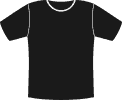
Shirts

Boots

Bags
Shoes

Gloves

Wallets
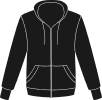
Coats/Jackets

Socks

Watches
A Unisex Guide To Dressing Ethically
Veganism is often confused for a dietary preference, but ethical veganism extends far beyond what goes on our plates and in our bellies!
When our aim is to dismantle the exploitation of animals, we become aware of the many ways in which we rely on, steal from, and otherwise use animals. Fashion is usually the next frontier, after diet, that vegans struggle to conquer.
Reducing and eliminating animal products from your wardrobe is a tricky thing, but hopefully with this handy guide, you will not only learn why it is important to skip these items on your next shopping trip, but how to find great clothes without the body count!
First Thing's First: Can vegan clothing be affordable?

Vegan clothing, much like other clothing, is going to be priced for a number of factors. Designer name, country of origin, source material, eco-friendly considerations like organic, recycled or wind-powered, and trendiness.
The good news is that the most expensive materials in the world are animal products, like Italian leather, silk Damask, and Cashmere, to name a few. That’s great news for a budget conscious vegan wardrobe! Clothing prices are a bell curve, with vegan clothing occupying the cheapest and almost most expensive ends, and animal products spanning the entire graph.
Clothing that you may already own, like jeans/denim, is already vegan by default, but remember to check for leather designs on things like tags and pocket details.
Vegan versions of luxury items will be expensive, much like the originals were, but I think you will find that you can while you can buy vegan Doc Martens for $150+ a pair, you can also go over to Payless and buy a knock-off for ~$20.
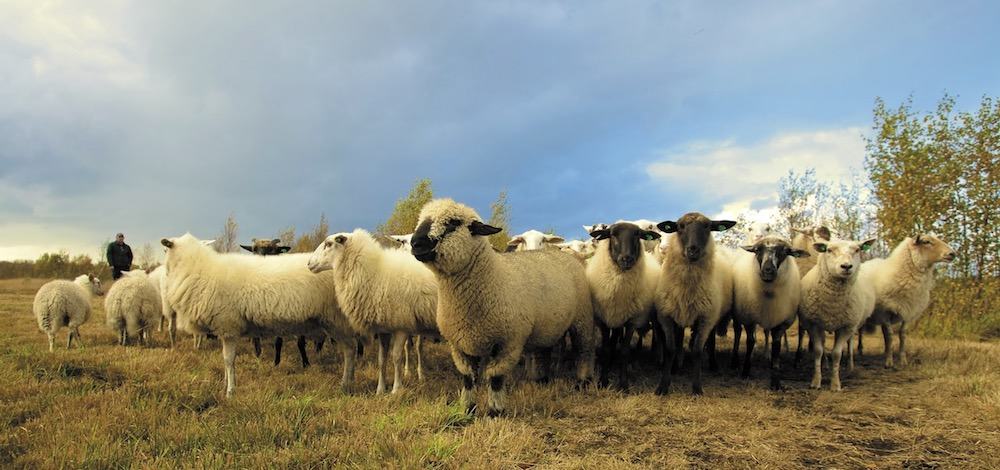
Part 1: The Wool Industry
The basic position of veganism is that raising an animal for our use means altering the living conditions for that animal. Since that relationship can not include consent, and very frequently involves the imprisonment, physical pain, or slaughter of those animals, it is considered inherently exploitative. A deeper look into these industries will also reveal why even many omnivores avoid participating in these industries.
The difference between wild sheep and domesticated sheep is an excellent example of this-- and it all comes down to two things: Breeding and Profit. By changing the fundamental ways in which we interact with animals, by seeing them as profitable and by breeding them to meet those profit seeks goals, we change their bodies, their health, and their life expectancies.
In the wool industry, sheep are bred so that they can produce more wool, or different thicknesses or colors of wool.
Here's a side by side view of domestic versus wild sheep and how this works out in the wool industry.
Do all sheep have to be sheared?
Contrary to myth, not all sheep need to be sheared. That’s where that breeding for profit idea comes into play. Wild sheep grow a thick fleece in the winter to protect them from the cold. They have naturally adapted to their environments, so that when spring comes, they naturally shed their winter coat, much like your pets do, and in different seasons they sport their brisk spring jackets or their sparse summer skivvies.
In short, wild sheep don’t need us at all. If you have ever gone hiking through Peru, Turkey, or Scotland, you’ll see tufts of mountain goat, llama, and sheep wool that they naturally shed, all over.
The most common wool in consumer products is from a sheep breed known as Merino. These sheep were bred to produce so much dense, fast-growing wool, that the sheep are not able to shed it themselves. It is because of this man-made breed that we think that sheep cannot shed their own fleeces. They were bred not to shed to ensure that all of their wool would end up in some human’s coat, and not caught by the breeze come springtime.
To add insult to injury, the largest wool industry in the world is in Australia-- not exactly winter coat weather downunder. Since these sheep cannot shed and lighten their coats with the seasons, many sheep in Australia die of heat stroke carrying around a few dozen pounds of extra fleece.
In places where the temperature does drop low enough for the sheep to need winter coats, the breeds that still shed are sheared too early. Shearing later in the year could result in losing wool, and as a result about 1 million sheep die each year from exposure to freezing conditions. A situation virtually unheard of for wild sheep in their native habitats, left unsheared.
The practice of Mulesing by ranchers
Part of breeding increased wool production for more profit resulted in sheep producing more skin, and more skin meant more wrinkles. We all get wrinkles, but with many animal breeds (e.g. Bulldog) the extra skin folds come with their own major health upkeep needs.
Skin rashes, infections, urine and feces all build up in those skin folds, and for farm animals like sheep flies lay eggs that hatch into flesh-eating maggots. Were the sheep able to shed their coats, these issues would be reduced, but not eliminated.
So, how does the wool industry address these hazardous side effects to breeding sheep for excess wool? The wool industry developed a rather medieval practice known as Mulesing.
Mulesing is the practice of cutting off pieces of flesh from the rump and tail of sheep. This is exactly what it sounds like, pieces of them are cut off, on a farm, with no anesthesia. As it turns out, this is just one of several non-anaesthetized procedures, including ear clipping and tagging, talk docking, and castration.So, we have a purpose-bred sheep, carrying far too much wool in hot Australia, missing pieces of his bum, tail, bits, and ears. That’s a Fairly grim existence.
To make matters worse, the sheep shearers, human workers who are paid to collect wool, don’t have the easiest time either. Enormous pressures are placed on them to gather wool faster, and it is atypical to have shearers paid hourly, but rather per sheep sheared.
If you have ever had to brush a dog or cat, getting an animal to comply with even simple activities can be a challenge. When you add the pressure of feeding your family into the mix, tensions are going to rise with each and every sheepish tendency. The sad fact is, in order to expedite the sheep shearing process, workers are often extraordinarily rough, to the point of downright abusive, to the animals, in order to receive barely living wages.
This video in Australia and this in the US, will show you everything you need to know.
Part 2: The Leather Industry
One of the more common misconceptions is that leather is an opportunity to reduce the waste leftover by the meat industry. Many people regard leather as a byproduct that would otherwise go to landfills. This misconception leads many to believe that not only is it ethically ok to buy and wear leather goods, but that it is ethically preferred.
It is important to understand that leather, in consumer goods, is usually the more expensive option or upgrade, for things like shoes and car interiors, and in the world of farming it is no different. By weight, leather is the most valuable commodity on the body of a Cow, and this fact is not forgotten when it’s time to slaughter the Cow. While not all leather, or meat, comes from cows, this fact is also true for the rare animal leathers like Kangaroo and Ostrich.
While some leather is gathered from the bodies of animals slaughtered for meat, or after milk bearing animals can no longer produce milk, it is important to recognize that breeding and profit are still very much at play.
Many animals are bred specifically for the quality of their leather, producing a wide range of qualities and types of leather, like kid leather to things like buffalo, bison, kangaroo, deer, and cow. This results in widely different prices for the consumer, but also vastly different farming conditions in which these animals live.
The factory farm that raises countless animals as livestock will sell off leather and any other animal parts as an income stream, but it is not an afterthought. These farms do not creatively reduce waste, but rather carefully market and create a demand for these products, and these products are factored into the profit strategies of these farms. Leather, like anything else, plays a major role in fueling the animal agriculture industry, by making it profitable-- without the demand for leather, the entire industry would be less successful.
The majority of the world’s leather gets produced in either China or India, and with very limited exception, they are not the world’s leading producer of meat, especially to the world’s top meat consumers, USA, Australia, and Italy. Those countries are however, the world’s leading leather consumers. Also interesting to note, that in much of India, slaughter of cows is illegal, and in much of China consumption of meat, from mammals whose hides we turn into leather, is very low.
China is the leading supplier of the world’s leather. In fact the top 5 countries supplying leather are China, Vietnam, India, Pakistan, and Indonesia. This should immediately paint a few pictures of the leather industry. The leather industry is primarily in the developing world where regulations against humans are often found lacking, and there are actually next to no regulations for how animals need to be raised, or slaughtered.
Practices like sweatshops and wage-slavery are commonplace in the garment and textile industry, and the leather industry in these countries is no exception. Additionally, it is highly likely that that the animals there are raised in conditions that would likely be illegal in the countries importing the leather, such as the country you live in. It is certainly illegal in the United States, where I live.
Furthermore, in India, where it is illegal to kill cows in many places, it is not illegal to raise cows for things like milk, so these animals are often milked during their life and then transported on foot or in crowded train cars to areas of India, or neighboring countries, where it is possible to kill the animal. The resulting stress of these mass cattle migrations results in huge amounts of injuries and deaths to both animal and farmer alike. It is a gruesome business.
For more information, check out this article.
Part 3: The Fur Industry
One of the more prominent vegan clothing topics is that of fur. The anti-fur movement spreads far beyond the ranks of vegans and vegetarians, and has thankfully been adopted by many in the mainstream, hurray!
A quick internet search on the topic can show you why: articles entitled “Still Unfashionably Cruel,” and “9 Shocking Fur Facts,” and perhaps most jarring: “The Fur Industry is Worse Than You Could Even Imagine”, you quickly see why.
The anti-fur movement gained ground for a long time, and fur fell out of fashion, occasionally being replaced by faux fur. However, fur is becoming trendy again, with several garments featuring fur pom-poms, trims, and many celebrities and fashion designers sporting full fur ensembles.
Why is fur cruel?
The nutshell for why fur is cruel comes down to: small cages that are so crowded the animals can’t move,cause bone deformations, and spread disease rampantly. These animals are kept in such stressful conditions, they are found to self-mutilate, to resist eating, and to resist breeding. Just like with humans, these are signs of extreme depression, and poor living conditions.
Much like leather, a lot of fur farms are in developing countries like China, where there are no animal safety regulations, or even pretenses. Many countries in Europe have outlawed the fur farming industry themselves, and the EU has adopted additional anti-cruelty measures to regulate the countries that do still allow it. However, all of these regulations encourage more farming in countries like China, with less rules and higher profit potential.
The most common animals for fashion fur are minks, foxes, chinchillas, and Asiatic raccoons, but there are also many animals including beavers, sables, and seals, that appear regularly in the fur trade. Being on the endangered species list, or respecting that list, can often vary from country to country too.
Furthermore, increased demands for fur, and an overall increase in the industrialization of farming methods, has meant that animals, like the popular mink, that previously were caught wild, are now almost entirely raised in brutal farm-cage conditions. In the case of animals like minks, this forces a social dynamic to otherwise incredibly solitary animals, and forces them to live in ways that bear no resemblance to their natural way of life.
The method of slaughter for fur animals is particularly grizzly, since minimizing damage to the skin is of the primary consideration for this industry. Preferred methods tend to be electrocution through anal inserts, and/or drowning.
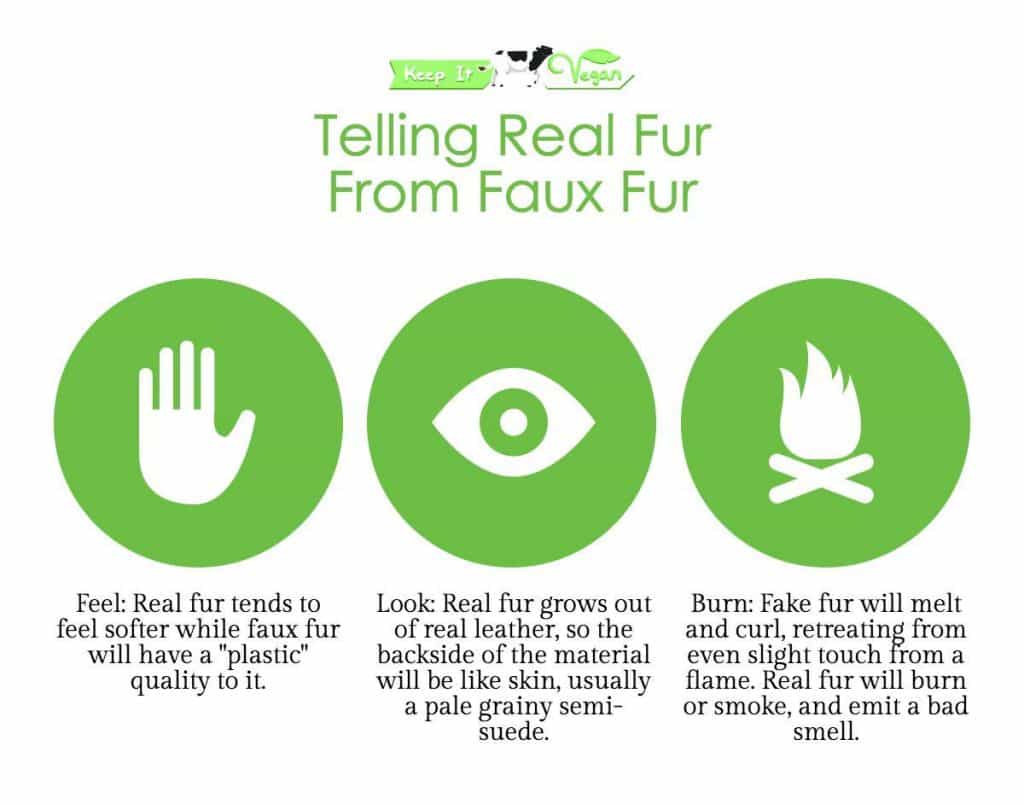
Telling real from from fake fur in the store
In most cases, the clothing you are looking to buy will have a garment label. The garment label says the name of the company, where it was made, how to care for it, and from what materials it was made. Terms like “synthetic fur”, “faux fur”, “fake fur”, or “man made materials”, will be the best indication that you are looking at something designed to look like fur, but not actually from a dead animal.
Pay special attention to details on labels that draw your attention to linings, “uppers” on things like shoes, or that separate out materials for different sections of the garment. This could mean that some sections are made from man-made materials (synthetic) but that others have genuine leather or fur.
Sometimes tags are missing or are hard to understand, and that’s ok. There are some good ways to determine if what you are looking at is real fur. Most of the time the company wants you to know if the leather or fur is real, because that increases the price.
Consider your own hair, versus a wig or a doll’s hair. Real fur typically feels softer and silkier than faux fur. Faux fur will have a plastic quality to it, that is more dull, and can even be crimped or crinkled. Additionally, faux fur has a slight stretch to the fiber because it is usually made of stretchy plastics and polyesters.
Another good method is to check the back and sides of the fabric itself. Real fur grows out of real leather, so the backside of the material will be like skin, usually a pale grainy semi-suede. The side will be thick and similarly grainy, and when you fold the material, the hair will part naturally, not in even rows.
Machine-made faux fur comes on a material that has a fabric backing, usually white, and will have a thinner edge, possibly with a bit of stretch, and will be smooth. The hair will be in linear rows, and can often be brushed in multiple direction because it doesn’t have a growth direction.
Have you ever accidentally burned your own hair? Then you’ll know your hair can actually catch on fire, and produces a terrible smell. The same is true of animal fur. This is not something to use when evaluating your potential new winter coat at the store, but if Grandma’s coat needs to be verified, you can pluck a couple strands, or find a hidden part inside the bottom hem, and just graze the fur with a lighter or candle. Fake fur will melt and curl, retreating from even slight touch from a flame. Real fur will burn or smoke, and emit that terrible smell.
Part 4: The Down & Feathers Industry
Feathers grow directly out from the skin of a bird. The stiff part of the feather you may associate with old timey quill pens, is deeper in the skin than our hair follicles are-- and if you have ever plucked or waxed, or had a particularly committed band-aid, you know that even that can really hurt.
Feathers are ripped from birds in large fistfulls at a time, while they are alive. This brutal process is done with such incredible force, that it leaves the birds bleeding, and often with gaping open wounds, that need to be sutured.
The birds used in the down industry are mostly Geese, who are also the central bird in the foie gras industry. This overlap has not been missed by either industry. It is important to remember that with breed and profit driving these industries, that feather down, regardless of the cruelty-free advertising in the industry, is related to Foie Gras, a food delicacy deemed so horrific it is banned in several countries, including the UK.
Recently, the fashion industry has tried to cater to consumer sympathy for the conditions in which down geese are raised. The average consumer does not want animals to suffer, however the practice of removing an animal's fur, skin, or feathers, is inherently torture. While it is possible to imagine worse and better forms of this torture, there isn’t a way to make the removal of a fundamental part of a bird (like feathers) anything other than physically and emotionally painful.
Marketing cruelty-free down, much like grass-fed beef, is a re-packaging with perhaps a 10% condition improvement. It doesn’t amount to much for the bird, only for the consumer’s conscience, and often results in higher prices for goods and more profits for manufacturers
Is silk vegan?
The short answer to this question is no. Silk is technically not even vegetarian.
A silk worm is a living creature, like a bird, a fish, or your own pets. Silk is produced as a waste and protective product by silkworms, mostly while they are inside of their cocoons. The way that humans harvest silk is to boil these cocoons, while the silkworm is inside. This process almost always kills the worm, and if it didn’t, it would remove a major resource from the worm, disturbing its pupal stage development, which would likely result in the worm’s death or malformation.
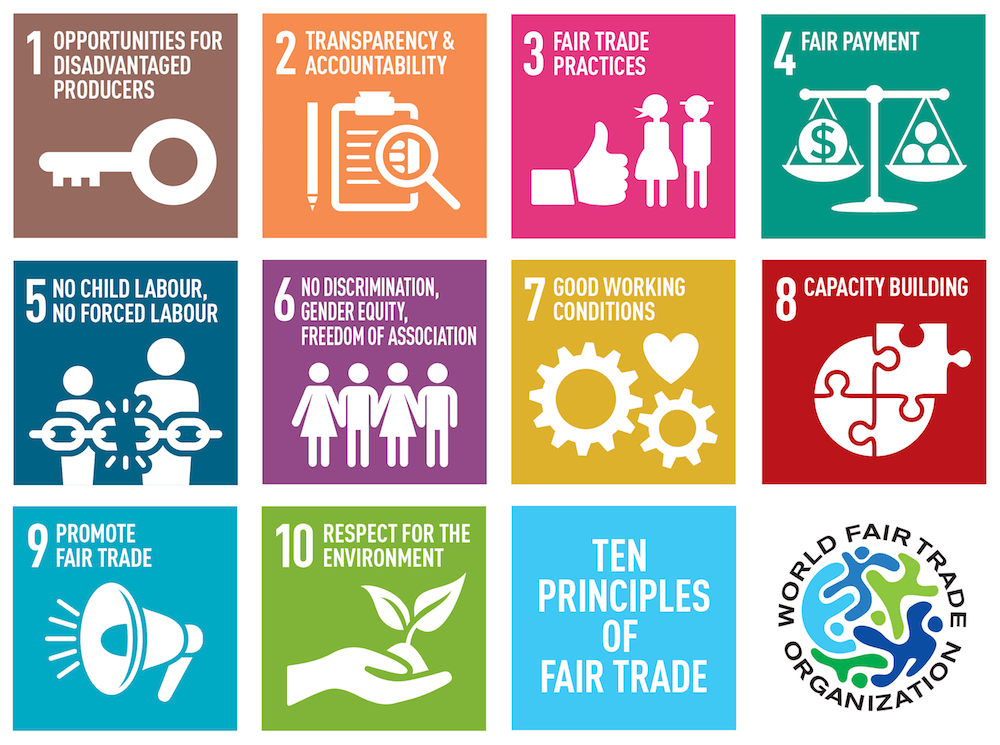
10 important principles of fair trade according to WFTO.
Fair Trade: One last variable to consider
Vegans spend a lot of time worrying about non-human animals. It's important to give a voice to the voiceless, and advocating for innocent animal lives is an uphill battle. However, animals aren’t the only groups exploited in the fashion industry, and they aren’t the only group that needs protection.
What does fair trade mean in relation to clothing?
Fair trade is a certification offered by several countries, and is a practice that governs things from trading regulations, purchase prices, sustainable methods, ethical farming practices, and conditions for workers.
These practices were developed to address the ongoing concerns that arise when wealthy first-world nations, like UK, US, France etc., buy raw goods and manufactured goods from developing countries like Guatemala, Kenya, and Thailand. These practices are designed to keep prices at fair levels, to ensure that workers are compensated adequately, that working conditions are safe, that farming practices are in line with environmental standards, and a variety of other things that vary by country to country and trade agreement to trade agreement.
Fair trade does not solve all problems in one handy little certificate, but it does indicate which companies, foreign and domestic, are making an attempt to consider sustainable and transparent business practices, and to reduce or eliminate exploitation.
How to be sure your clothing is fair trade?
Some clothing you may come across will be certified fair-trade. In this case, the certified fair trade logo will appear on the garment label, package, or on the company website. This can mean that the fabric that was later sewed together is fair-trade (like the yards of cotton that they make the t-shirts out of) or it can mean that the factory that produces your shoes is fair-trade.
Failing that, research is your best bet. Seek out and select companies that are in line with your ethics. Mashable has a list of a few apps you can use to look up brands when trying to determine the ethics of the sources you are buying from.
Vegan Clothing Materials: What's available?
Better living through chemistry, what a time to be vegan! Thankfully, there are countless fabrics out there, and some incredibly inventive designers and handcraft companies that are doing truly cool things these days. When in doubt, take a browse through Etsy or Pinterest with “veggie” or “vegan” clothing in the search. You will not be disappointed!
Wool alternatives
Not all sweaters are wool. Many things you may think are wool are in fact something like acrylic, cotton, and even linen. Additionally, for those of you who knit, there yarns made from things like hemp and bamboo that are worth checking out. Bamboo and hemp are also becoming more and more available in consumer products, and typically are produced with eco-friendliness in mind.
Leather alternatives
Definitely check out StyleOnVega's awesome article on Vegan Leather - Great read! They also have a pretty great free eBook on ethical fashion.
Luckily the demand for and cost of leather means that many alternatives have been developed over the years, and the quality keeps getting better. Some materials are designed for durability, for things like shoes and belts. Some materials are made to mimic real leather, with skin textures, or ostrich bumps, and the snakeskins you may already know.
Additionally, leather alternatives can be made from things like PVC, cork, algae, microsuede, latex, neoprene and many other materials!
Environmental Notes on leather alternatives
According to Zerxza's article, discussing the environmental aspects of vegan leather, "Most vegan leather is basically the combination of a plastic coating bonded with a fabric layer."
The article goes on to say: "Making this faux leather creates toxic chemicals and substances, such as dioxins, chlorine and carcinogens. This makes it an unhealthy choice for the environment."
This is an important warning that not all leather alternatives are created equal. However, there are still plenty of eco-friendly leather alternatives for brands to use in their products.
Silk alternatives
WWII did great things for the artificial silk industry. Before the war, rayon had just given birth to its love child nylon, a perfect synthetic analog for silk. During the war, nylon demand skyrocketed, increasing the efficiency of nylon production. The rest is history. Between these two, rayon and nylon, no one ever need crave the smooth luxury of silk again.
Additionally, many cotton products, specifically the soft mercerized cotton, and many polyesters, are made to resemble silk, and the silk material satin.
The Tough Question: Should you give away non-vegan clothing?
This is an intensely complex issue, and it is a question every vegan asks, and re-asks, themselves. The major points to consider are:
- Am I putting in a demand for more animal products, and thus contributing to the industry?
- Am I promoting the use of animal products, or sending a positive message about animal product use to others around me?
- Am I creating unnecessary waste?
- Am I comfortable with the clothing I am wearing/owning?
Before deciding to throw away clothing, have you considered donating clothing to local homeless shelters, animal rescues, or to humanitarian aid organizations?
Whenever we make choices for ethical reasons, at the heart of this is a desire to do the least harm: that includes to yourself! For example, don’t freeze all winter because you can’t afford a new coat, and don’t miss an opportunity for compassion, by throwing out a good coat when another person could be clothed by it.
Also, these garments have lifespans. Wearing your shoes, belts, coats, or sweaters until they are worn out and then replacing them with vegan items is a choice that may match your ethical and financial needs the best. Waste doesn’t serve the animals, the planet, or you.
Some animal products, like silk, fine leather, and fur especially, have high value. In this case, you may decide that instead of wearing these animal products that you prefer to sell them to someone without your ethical concerns. Etsy, eBay, Tradesy, Twice, Thredup, or Poshmark are all excellent places to look into selling your re-sellable goods.
One more option is to donate fur or down items to animal shelters, where these items can comfort animals in high stress situations. Many shelters can not afford much to add to the temporary comfort of the animals in their care, and these items are effective tools for rescue cages.
Meet The Vegan Clothing Brands
Country-Specific Brands:
USA | Canada | UK | Australia |
|---|---|---|---|
Vaute | SickOnSin | Wilby Clutch | Velvety.com.au |
PLNT BSD | Healing Heart Designs | The Third Estate | Veganstyle.com.au |
Lip Service | Cherry Berry Handbags | ||
Tripp NYC | Truth Belts | ||
Matt & Nat |
- Herbivore Clothing
- Noharm
- Brave Gentleman
- Good Guys
- Create&Case
- Harper + Lange
- Kat Mendenhall Boots
- Beyond Skin
- Loomstate
- Bungalow 360
- Olsenhaus
- Calico Dragon
- Tamar Shalem (shoes)
- Moo (shoes)
- Charlie Butler (Shoes)
- Doc Martens (have a few vegan shoes)
- H & M
- Stella McCartney
Vegan Fashion Blogs You'll LOVE
If fashion is your passion, chances are that you will be looking for some new blogs and influencers to follow. In this section we go over various blogs for men and women alike.
For Men
Men's vegan style/fashion blogs are a LOT harder to come across. If you know any additional choices, do let me know in the comment section below. If you're thinking of starting a vegan men's style/fashion blog, it would be a great niche to to the low-competitive nature.
- The Discerning Brute - Here is the only vegan men's style blog I have come across. It covers many topics in great detail. The writer of the blog, Joshua Katcher is very qualified, being a fashion designer himself (He owns Brave Gentleman).
For Women
- Style on Vega - An incredible treasure-trove of info on vegan fashion. Elisa, the founder, describes the blog in the following way: "My blog was created for the conscious alternative and edgy woman like you, who cares about the animals and the planet but doesn’t want to sacrifice her style."
- ThePurist.life - This blog focuses on beautiful, luxurious fashion that is 100% ethical. It was created by Natalie out of Toronto, Ontario. While this blog is great no matter where on the earth you find yourself to be, it is especially great if you live around the city of Toronto. There are plenty of great local shopping guides to make your life a bit easier.
- Eluxe Magazine - Think of Eluxe as a vegan lifestyle magazine. While covering mostly sustainable fashion, you will also find many, many articles on clean beauty, wellness, and "eco luxury travel".
- EthicalElephant - This is a very well-organized vegan lifestyle blog featuring a ton of guides to help you dress and live vegan.
- ChicVegan - ChicVegan covers a ton of topics not all relating to vegan fashion. You could easily filter only their fashion-related articles by clicking that "Fashion" button in their navigation bar. Their about page describes the blog as "a place where compassionate fashionistas and vegan vixens meet up to discuss how they can make the world a better place for people and animals alike."
Final Notes
Veganism is an ethical stance beyond diet, and for many navigating vegan clothing can be tricky. The animal industry is one riddled with cruel practices, and even the seemingly harmless industries like wool and silk, quickly become revealed as horrifying.
When it comes to replacing your current wardrobe, there is no approach that works for everyone, and this is likely to be a process that is personal to your ethics and financial considerations.
The good news is that there are many excellent vegan clothing options, and alternatives to garments that were previously made with leather or wool. Fashionable veganism is possible, and affordable veganism is possible, so now it’s better and easier than ever to be vegan!
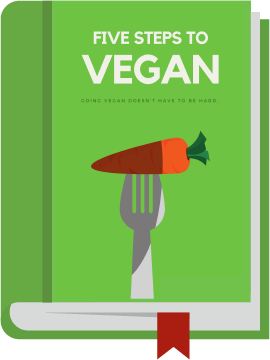
Leave a Comment
One comment
bshbiz